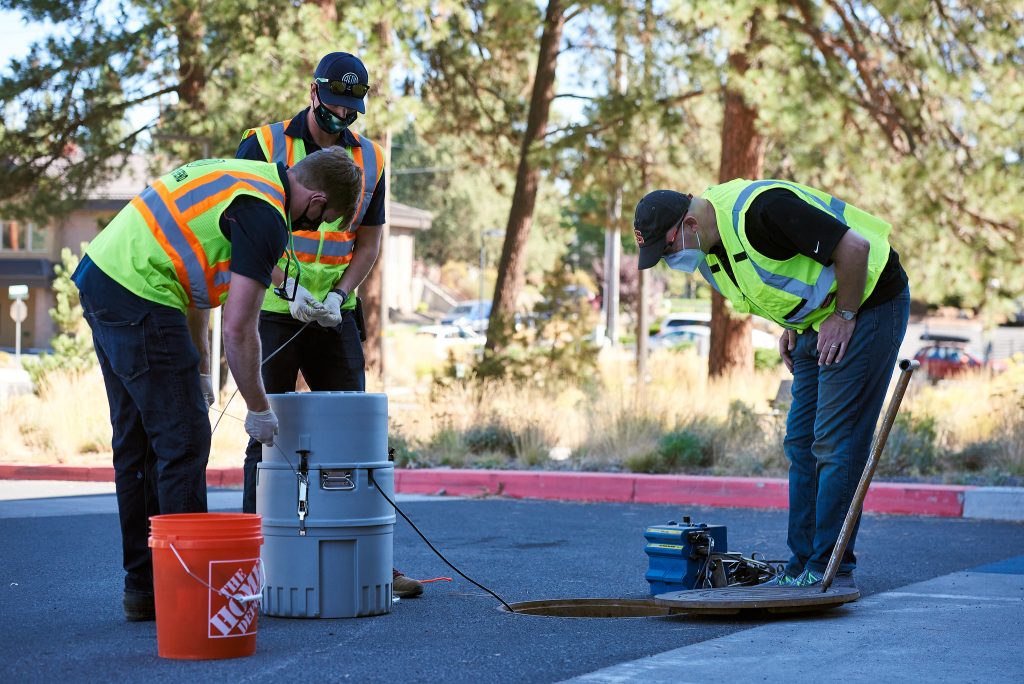 The Corvallis Wastewater Project, a collaborative effort between the City of Corvallis and researchers at Oregon State University, is currently detecting unexpected rises in viral COVID-19 RNA in the city’s wastewater. All the monitored regions of the city – North Corvallis, South Corvallis, Southwest Corvallis, the Beca Avenue drainage, lower Corvallis, and all wastewater filtered into the city Wastewater Facility – had been experiencing declines in COVID RNA prevalence after the holidays and continuing to around mid-to–late-February. Now, the story is changing.
The Corvallis Wastewater Project, a collaborative effort between the City of Corvallis and researchers at Oregon State University, is currently detecting unexpected rises in viral COVID-19 RNA in the city’s wastewater. All the monitored regions of the city – North Corvallis, South Corvallis, Southwest Corvallis, the Beca Avenue drainage, lower Corvallis, and all wastewater filtered into the city Wastewater Facility – had been experiencing declines in COVID RNA prevalence after the holidays and continuing to around mid-to–late-February. Now, the story is changing.
Starting the last week of February, viral RNA detected in the city wastewater started to trend upwards rather than downwards. This positive trend has only intensified in the last three weeks and now all regions of Corvallis, except for North Corvallis, are experiencing a rapid increase in COVID RNA in wastewater samples.
“It looks like we’ve lost the progress that we had made,” explained one of the project’s head researchers, Dr. Taal Levi, via email. “I try not to overinterpret any one week, but this is a very noteworthy increase given the increase across all these independent basins.”
In general, the Corvallis Wastewater Project has noted that areas of the city where people aged 18-29 years old – primarily University students – densely reside were the areas where viral RNA remained the highest among citywide samples. However, now regions like South Corvallis and the Beca Avenue area are on the rise again as well, which seems unlikely to be linked directly to the OSU student body.
The project is detecting these sharp increases in viral RNA in wastewater as Benton County just de-escalated from an “extreme risk” category of potential COVID transmission to a “high risk.” This means more and slightly larger social gatherings are allowed, and bars, restaurants, and businesses may increase their patron capacity. Elementary and grade schools are also transitioning to a hybrid program of partially in-person learning, and the Corvallis School District is currently welcoming kindergarten and first graders back to classrooms this week.
The Wastewater Project was started in the summer and has been sampling wastewater from multiple locations throughout Corvallis weekly. This is considered one of the best methods of surveying virus presence in the city, because it can monitor numerous small or large regions, providing high-resolution data to help pinpoint where hotspots of transmission may be. In addition, this type of virus tracking does not rely on individuals to take it upon themselves to get tested, so this sampling is fast and can show changes in confirmed case trends before the county or state has the days’ or weeks’ test results.
County Caseload
It should be noted that, as of the publishing date of this article, Benton County’s COVID-19 data tracker does not yet reflect this increasing prevalence of the virus among its confirmed case statistics.
It’s unclear why reported case rates are not yet similarly spiking in the county, and it’s unknown if they will increase to mirror the trends in the wastewater in the foreseeable future. It is possible there is a lag between viral RNA shedding into wastewater and the amount of time it takes residents to get tested for the virus at a clinic or through the OSU TRACE program. It will be important to remain vigilant and keep an eye on case rates reported within the county in the coming weeks.
Despite uncertainties, this is potentially concerning news for Benton County and Corvallis. The spiking prevalence of COVID RNA in the city’s wastewater comes amid calls from the Centers for Disease Control and Prevention for states not to rush the re-opening process, relax mask mandates, or let their guard down.
Of the over 93,000 people who live in the county, only 14,200 have been fully vaccinated. While the possibility of future increases in vaccine supply is promising, we must remember that only accounts for 15% of Benton County residents. This is nowhere near the number of fully vaccinated individuals we need for herd immunity.
The community needs to remain vigilant if we hope to return to normalcy and be able to enjoy a worry-free meal with friends or a family party by the summer.
While there is a light at the end of the tunnel, we need to remember we are still very much in the tunnel.
To learn more about the Corvallis Wastewater Project and view data as it gets updated weekly, visit https://agsci-labs.oregonstate.edu/levit/corvallis-wastewater-project/
The Corvallis Advocate strongly encourages everyone to wear masks in public, to social distance, and to stay home whenever possible.
By: Lauren Zatkos
Do you have a story for The Advocate? Email editor@corvallisadvocate.com


